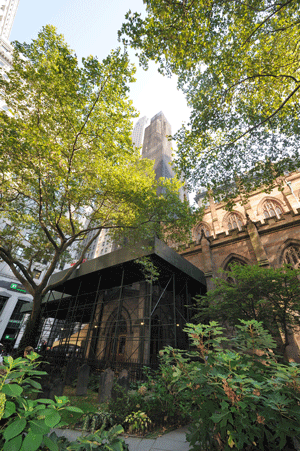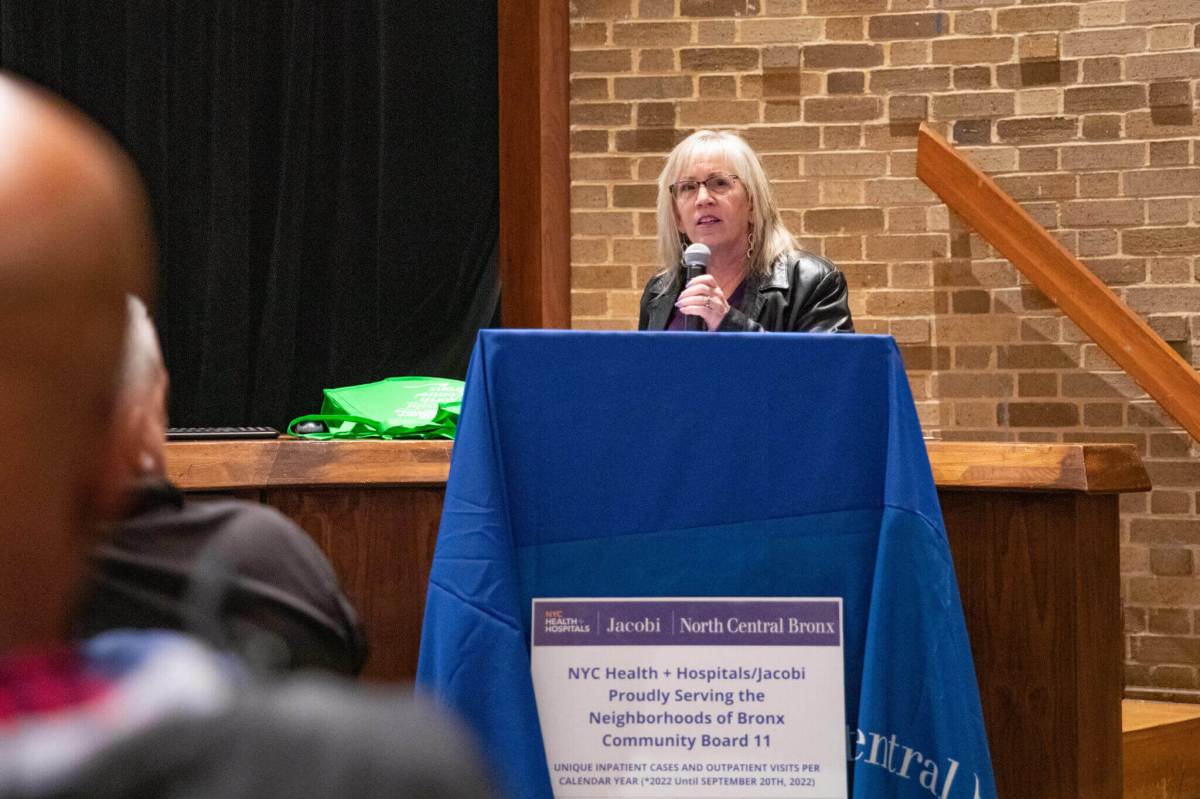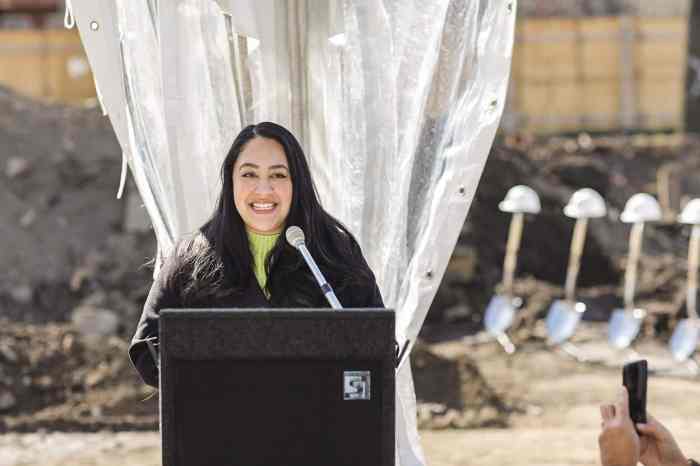
BY TERESE LOEB KREUZER | Architect Richard Upjohn’s Gothic masterpiece, Trinity Church, has stood at the corner of Wall Street and Broadway since 1846. This year, it is getting a facelift.
Since July, the church’s iconic front has been shrouded in scaffolding. For the first time since 1992, when the church was cleaned and repaired, conservators ascended to the cross 280 feet from the ground to undertake the painstaking task of assessing the condition of the spire and the massive tower beneath it. As workers began repairs on one level, surveyors moved to the level below it to see what needed to be done.
The spire appeared to be in fairly good condition, considering that it hasn’t been worked on in years, according to Tricia Atallah, director of Mission Properties and Businesses, the maintenance and preservation department of Trinity Wall Street, the church’s parish. The tower under the spire is in worse condition, she said, though not in dire straits. “We want to take care of safety concerns — loose elements that could fall one day. We will do some preventative work so that the spire and the tower will be good for the next 10 to 20 years.”
A major problem has proven to be that much of the church was previously pointed with a mortar mix of lime, sand and cement that yielded hard, impermeable mortar.
”Water is normally supposed to come through the mortar joints but the water is getting trapped [by the hard mortar] and it’s coming through the stone,” said Luke S. Johns, construction project manager for Mission Properties and Businesses. “As it comes through the stone, it’s causing more and more damage.”
Because the church is built of brownstone, which is relatively soft, removing the hard mortar, where necessary, is time-consuming. Should some of the brownstone prove to be badly damaged, it will be fixed with what Johns called “a Dutchman repair,” in which a portion of the stone is removed and pins are inserted in the stone. In extreme cases, he said, the crew would remove a complete stone.
The spire and tower are being cleaned, not only for aesthetic reasons but to remove moss, which traps water.
The church, whose parish dates from 1697, is one of the most historic sites in Manhattan. The current church is the third in this location. “We may have archaeologists working with us depending on what we bump into,” Atallah said. Unless something unanticipated arises, Trinity Wall Street expects to be finished with the restoration by early next year, at the latest.
At the same time that it is working on the church building, Trinity Wall Street is reinforcing the brownstone wall that surrounds the churchyard. Parts of the wall are more than 225 years old. “Last year, we did a survey of the wall with a structural engineer, and it was determined that some areas of the wall are exhibiting stress,” said Atallah.
The wall was supposed to be repaired in fall 2001, but the destruction of the nearby World Trade Center intervened. In 2002, work was halted upon the discovery of buried skeletal remains.
The churchyard is situated on some of Manhattan’s original soil. Before landfill expanded the contours of the island, the Hudson River lapped close to the churchyard wall.
The downward slope of the churchyard causes drainage problems, according to Atallah. “Water comes down from the church roof and drains into the soil, and the soil pushes against the wall,” she said, adding that the wall was never well reinforced to begin with.
“We did some work in 2003 and reinforced parts of the wall, but it was of limited scope,” said Atallah. “Our structural engineer recommended that we do it right this time.”
The church is bringing in masons and consultants who specialize in the restoration of historic buildings. They will start work on the north corner of the wall and then move to the south corner.
“You can imagine how tricky it’s going to be to work on this street with all the buses and the tourists and the trucks and the police,” said Atallah. “We have to set up a staging design where pedestrians will be safe and there will be no interference in the traffic flows.”
In addition to staying out of the way of the living, the workers will have to avoid disturbing the dead. Trinity Wall Street hired a company with ground-penetrating radar equipment to map out the depth of the vaults in the graveyard. “Using that report, we went to our structural engineer, and they did the calculations so that the soil anchors will go down at a specific angle and won’t interfere with the vaults,” said Johns.
The churchyard wall is two to three feet thick and has a section of smooth stone beneath older stones that are roughly hewn.
“When they constructed the subway station here, they actually lowered the sidewalk elevation,” explained Johns. “The lower part of the wall was done in the 1920s when the train station was put in. The upper part is the older part of the wall. They would have done that by underpinning the existing wall and then digging under it.”
To repair the wall, each stone that is removed will be numbered and eventually replaced in its original position. “One of the tricky parts of doing this is that we don’t know the size of each individual stone,” said Johns. “Our masonry consultant has approved the procedures, but there are discrepancies that you never can know until you actually do it.”

















